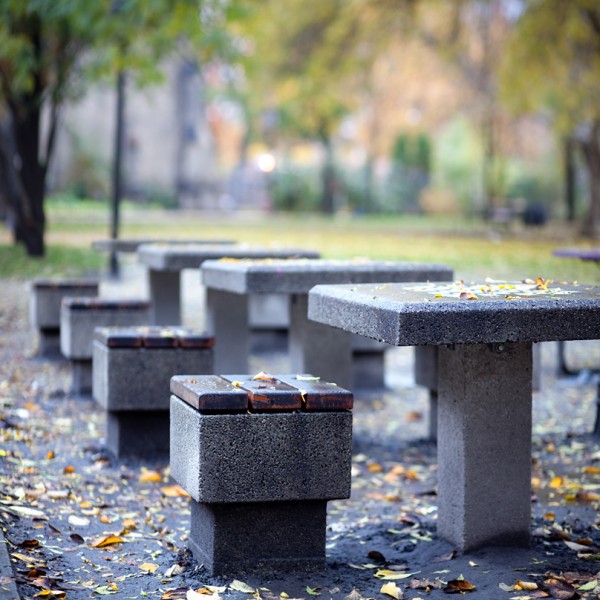
For years, I’ve played pick-up hockey on Thursday evenings with a group of guys at Campbell Park, a somewhat forlorn space near Dupont and Lansdowne. The rink, which doubles as a tennis or basketball court in the summer, sits adjacent to a little clubhouse.
Early on, the clubhouse — a cinder-block shoebox with a pair of grim bathrooms and a kitchenette — was nothing more than a desolate change room. But a few years ago, Jutta Mason and her intrepid parks reclaimers at CELOS (Centre for Local Research into Public Space), colonized the Campbell Park clubhouse. Little by little, stuff began to accumulate there – some tables and chairs, games, toys, appliances, crates containing spare hockey gear, etc.
The bored Parks & Recreation guy who hung out in the kitchen disappeared, and a succession of young people have taken over, cooking this and that, yakking with the kids who hang out. Campbell was getting the Dufferin Grove treatment, one found object at a time.
As far as I know, this transformation has been less hard-fought, and somewhat less ambitious, than Mason’s original project. That fight involved years of turf wars as she and the CELOS activists sought to wrest Dufferin Grove Park from the clutches of both the local drug dealers and the parks mandarins at City Hall.
Mason, as it turned out, had more will power than either gang. The question is, has the City really absorbed those lessons about establishing better and more constructive relationships between local community groups and specific parks?
Toronto Park People (TPP), which will have its third summit this weekend, and the Garfield Weston Foundation plan to test the proposition. Their new $5 million/3-year program, announced yesterday [ PDF ], will allow local organizations apply for grants to invest in improvement projects to parkland owned by the City, Toronto Community Housing or the Toronto Regional Conservation Authority.
TPP executive director Dave Harvey says the grants can either go towards programs or events, as well as more complicated capital projects, such as tree planting, natural playgrounds, food gardens, trail improvements and so on. The grants, the group says, may range from $25,000 to $750,000, and the aggregate will not exceed the $5 million. The organization will vet applications twice a year.
Harvey’s goal, besides the local improvements per se, is to re-wire the relationship between community groups, the City and neighbourhood parks. In many U.S. cities — New York being an especially vivid example — conservancies have become well-established institutions, serving as intermediaries between the public and municipalities. The Big Apple’s Central Park Conservancy (CPC) emerged in the wake of the city’s financial meltdown and the associated decay of the park. Since 1980, it has raised a stunning $600 million, mostly from private sources, for park improvements and stewardship. It maintains much of the space and runs programs.
While the CPC is by far the largest conservancy, there are many others, including Winnipeg’s Assiniboine Park. Yet there are no comparable examples here, with the exception of the Evergreen Brickworks, which has been supported for years by the Westons and other philanthropists, including many corporate donors.
Toronto has parks that have had makeovers thanks to an infusion of Section 37 cash, as was the case with the remade Jean Sibelius Park in the Annex. But with the new grant program, TPP is pushing past a door that hasn’t been opened before in a systematic way: using donated cash to underwrite changes to a public park.
It will be intriguing to see how the City responds to a project that received funding from TPP. Many smaller parks are simply ignored, but others have served as stages for complicated and divisive local debates over dog runs, playground improvements, skate park plans and non-conforming uses, such as the illicit but popular BMX trails in High Park.
When local groups come to the city with the TPP’s cash and an improvement plan, the parks department will obviously sit up and take notice. After all, money talks, especially for an organization like Parks & Recreation, which, TPP says, spends over $300 million a year on operations and upkeep.
But that’s when the process questions click in: What happens if the City doesn’t like the plan, or if the local councillor decides he or she won’t support an approved project for political reasons (e.g., it upsets a friendly ratepayer group)?
Harvey, whose organization has helped CELOS in the past, understands that those grassy expanses may contain more than a few landmines. So he recommends that prospective applicants collect the necessary local backing before they submit their applications. “These are public spaces and the work needs to be done to build a proposal that has broad support,” he says. “Those are the best kind of projects anyway, because they’ve got lots of buy-in.”
photo by Miles Storey





3 comments
Excited to see what type of projects are proposed and funded by the foundation! We need more of this type of philanthropy!
Is this another reflection of the public sector in North America’s inability to delivery value for money? Why is it we need to rely on private donors and why is it that a small group of people with commitment and a bit of energy are so much more productive than the public service arm of the city?
@David
I think this is a reflection of the degree to which the public are willing to pay taxes for things like Parks and Recreation. John mentions that there was one solitary worker at this park, which was probably all that the Parks and Rec budget could afford. Could one worker effect this transformation on their own? No chance. That’s why we need to rely on the community to self-organize these types of improvements in public space. I read this story as a celebration of civic engagement, not as a condemnation of public sector efficiency.